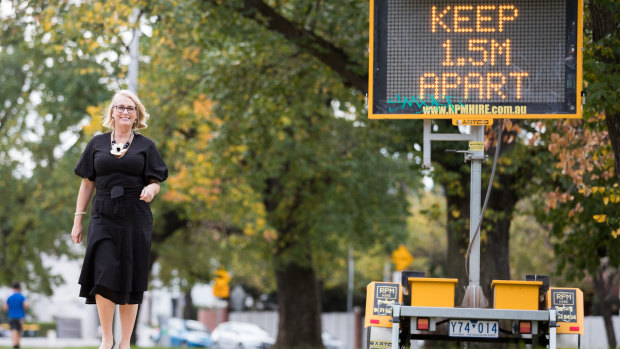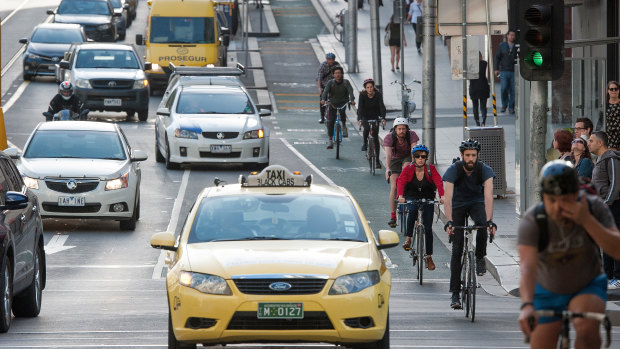- Exclusive
- National
- Victoria
- Coronavirus pandemic
This was published 5 years ago
Car parks out, footpaths and cycling lanes in as city prepares for post-COVID commuters
By Timna Jacks
Car parks will make way for footpaths and 12 kilometres of pop-up cycling lanes will be built to allow people to socially distance in Melbourne's city centre as COVID-19 restrictions start to ease.
The move by Melbourne City Council follows the lead of cities such as Berlin and Milan, which are redrawing road markings to create more room for cyclists and pedestrians during the coronavirus pandemic.

Melbourne lord mayor Sally Capp yesterday next to a sign urging social distancing.Credit: Jason South
Lord mayor Sally Capp said car parks would be removed at busy pedestrian areas to enable the extension of footpaths, while 12 kilometres of new temporary bike lanes will be created, with a plan to make the upgrades permanent if they turn out to be successful.
“Given it will take time for a vaccine to come into play, we have a responsibility to provide more space for pedestrians," she said. "Increasing pavements around the city will involve our need to take back some of our on-street parking to accommodate wider footpaths and bike lanes.”
The changes are part of a push to fast-track projects funded under the council’s draft budget to be released next week, including transport initiatives flagged in the council's 2030 Transport Strategy.
With cycling numbers reaching record levels during lockdown as road traffic fell by 88 per cent, it is hoped the new moves will encourage people to permanently switch their mode of transport.
The council is still deciding on locations for the new cycling lanes, but upgrades already approved for Exhibition Street and plans for cycling lanes in Elizabeth Street are likely candidates.
A mixture of line markings and separation barriers will be used along the temporary bicycle lanes, at least initially.
“We are looking at ways of using protection that may not be permanent," Cr Capp said.
Planners are expecting an increase in vehicles travelling into the city as lockdown measures are lifted, with many commuters likely to avoid crowds on public transport.

Cyclists in La Trobe Street in the CBD. Credit: Jesse Marlow
Cr Capp called on businesses to stagger their work hours to spread the peak flows, with the council’s 1600 staff set to return in a staggered fashion.
"We can't have everyone jumping in their cars, because we’ll end up with a bigger congestion issue than we had pre-COVID," she said.
“We have to find ways of utilising public transport whilst adhering to social distancing and staggering start times."
The council is co-ordinating a plan with Yarra Trams to ensure services don't get overcrowded at the start of each line, before entering the city.
Councillors also hope that plans for shared-use zones on Melbourne’s “Little” streets and lowered speed limits to 30km/h will get the green light from the Transport Department.
Cleaning of high-touch points will continue in the city and hand sanitiser will be handed out, while staff will be deployed to assist with social distancing as people start to return to school and work.
All roads will remain open to ensure a free flow of delivery services.
A Bicycle Network count of 8800 riders on April 25 showed the number had increased by 270 per cent compared with November last year.
There was a 221 per cent increase on the Capital City Trail, from 219 to 703 cyclists.
On the Moonee Ponds Creek Trail, there was a 303 per cent increase, from 102 to 411 riders.
Bicycle Network chief executive Craig Richards said many public transport commuters will want to ride to work instead and "we have to have bike lanes ready to roll.
“On-street car parks can be turned into cycleways overnight with a few bollards and reflective tape. It’s quick, cheap and being done all over the world.”
Victoria Walks executive officer Ben Rossiter said there was a marked increase in walking during lockdown and it was crucial that all levels of government made the most of the opportunity to encourage good travel patterns.
“From a behaviour change point of view, there is a real opportunity to embed this increased walking in people’s every day routines.”